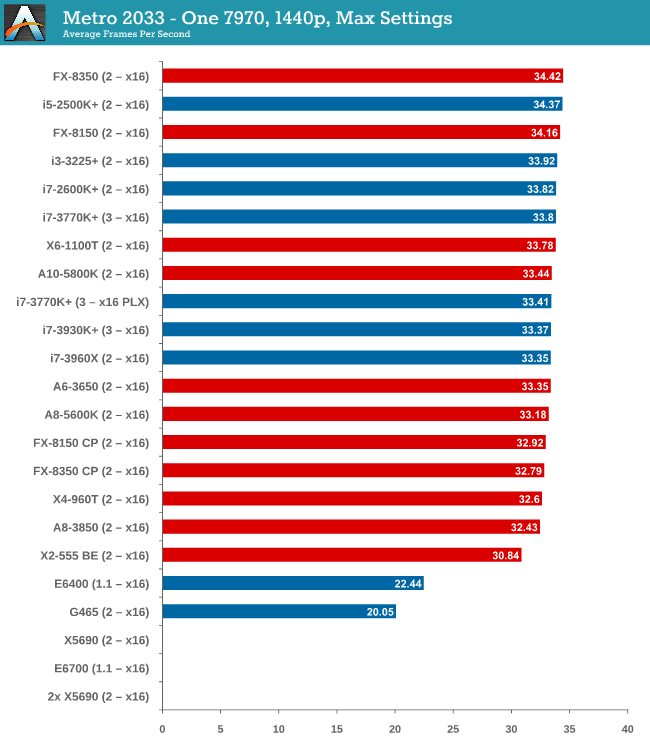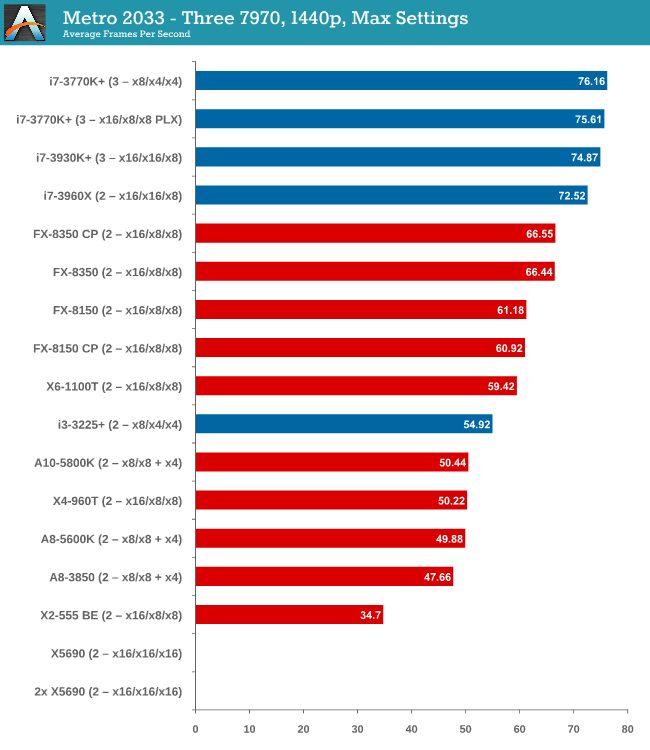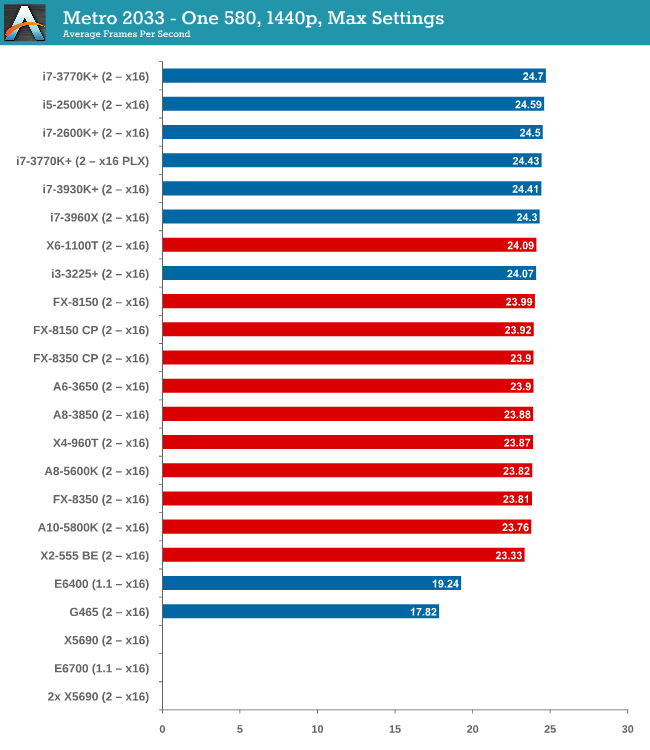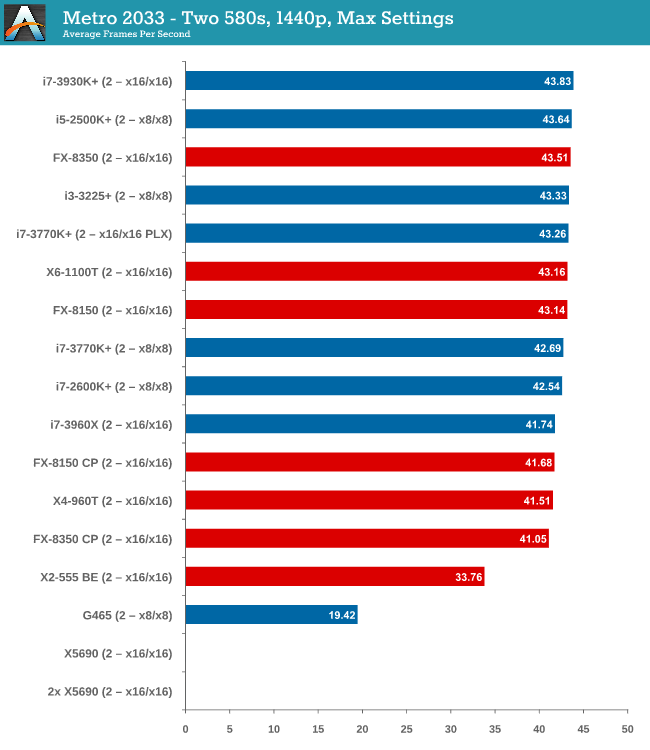Choosing a Gaming CPU: Single + Multi-GPU at 1440p, April 2013
by Ian Cutress on May 8, 2013 10:00 AM ESTMetro 2033
Our first analysis is with the perennial reviewers’ favorite, Metro 2033. It occurs in a lot of reviews for a couple of reasons – it has a very easy to use benchmark GUI that anyone can use, and it is often very GPU limited, at least in single GPU mode. Metro 2033 is a strenuous DX11 benchmark that can challenge most systems that try to run it at any high-end settings. Developed by 4A Games and released in March 2010, we use the inbuilt DirectX 11 Frontline benchmark to test the hardware at 1440p with full graphical settings. Results are given as the average frame rate from a second batch of 4 runs, as Metro has a tendency to inflate the scores for the first batch by up to 5%.
One 7970

With one 7970 at 1440p, every processor is in full x16 allocation and there seems to be no split between any processor with 4 threads or above. Processors with two threads fall behind, but not by much as the X2-555 BE still gets 30 FPS. There seems to be no split between PCIe 3.0 or PCIe 2.0, or with respect to memory.
Two 7970s

When we start using two GPUs in the setup, the Intel processors have an advantage, with those running PCIe 2.0 a few FPS ahead of the FX-8350. Both cores and single thread speed seem to have some effect (i3-3225 is quite low, FX-8350 > X6-1100T).
Three 7970s

More results in favour of Intel processors and PCIe 3.0, the i7-3770K in an x8/x4/x4 surpassing the FX-8350 in an x16/x16/x8 by almost 10 frames per second. There seems to be no advantage to having a Sandy Bridge-E setup over an Ivy Bridge one so far.
Four 7970s

While we have limited results, PCIe 3.0 wins against PCIe 2.0 by 5%.
One 580

From dual core AMD all the way up to the latest Ivy Bridge, results for a single GTX 580 are all roughly the same, indicating a GPU throughput limited scenario.
Two 580s

Similar to one GTX580, we are still GPU limited here.
Metro 2033 conclusion
A few points are readily apparent from Metro 2033 tests – the more powerful the GPU, the more important the CPU choice is, and that CPU choice does not matter until you get to at least three 7970s. In that case, you want a PCIe 3.0 setup more than anything else.










242 Comments
View All Comments
HisDivineOrder - Thursday, May 9, 2013 - link
Shhhhhh. You're using too much of that stuff called sense. It might spread and suddenly everyone would want case reviews that reflect what anyone who'd install a motherboard in 99% of the cases they review instead of miniITX for every review. I mean, there's no way that putting a miniITX or microATX into every case review isn't going to impact the actual case being reviewed, is there?IS THERE?
crimson117 - Thursday, May 9, 2013 - link
Agreed - why review a full tower with a micro atx? Who builds like that?Gigaplex - Sunday, May 12, 2013 - link
I do. Is that a problem?Blibbax - Wednesday, May 8, 2013 - link
If you're recommending the A8-5600K, but for people with a discrete GPU, aren't you really recommending the FX-4*** series?Ortanon - Wednesday, May 8, 2013 - link
Excellent question.IanCutress - Wednesday, May 8, 2013 - link
Good point - apart from not testing the FX-4xxx processors (I don't have any), the FX-4xxx uses an AM3 platform - the FM2 platform is both newer and the chipsets offer more native USB 3.0 / SATA 6 Gbps as well as a UEFI BIOS from the ground up. The FX-4xxx is still a relevant choice with its L3 cache, and a couple of newer boards have been released to try and get the best from the 990FX chipset. Though out of what I have tested so far, the A8 makes the most sense if you're looking at pure 1-GPU gaming. If I get an FX-4100 in, it will be tested and conclusions adjusted if it performs similarly - there's no point suggesting a CPU I haven't tested and can't back it up with data.Ian
Blibbax - Wednesday, May 8, 2013 - link
I entirely agree that it'd be wrong to make conclusions without data. However, I feel like the APU recommendation ought to go with some sort of "however..." caveat.I look forward to your FX4 and FX6 results, however. I was initially not at all sold on these chips, but now that the prices have come down and the FX6 is often priced against Intel's i3, they are much more compelling.
DeathReborn - Wednesday, May 8, 2013 - link
There's always the Athlon II X4 750K BE which still uses FM2 but lacks the IGP.Cow86 - Wednesday, May 8, 2013 - link
If you're going to compare it against Trinity APU's, then wouldn't it be fairer to get an FX-4300, based on the same piledriver core? See if that L3 cache makes enough of a difference? More up to date as well...kmmatney - Wednesday, May 8, 2013 - link
If you live near a microcenter, you can get an FX-4130 (3.8 Ghz) and motherboard for $99. That leaves quite of room to get a better GPU, and probably a better overall gaming experience for a given amount of money. I upgraded from an X4-955 to a 3570K about 6 months ago, and have to admit that I barely notice the performance increase in games, and would have probably been better off spending the $250 on a better video card. I do like the extra speed while using handbrake, though, and my son likes my old X4-955 that was a big upgrade from his previous setup, though.